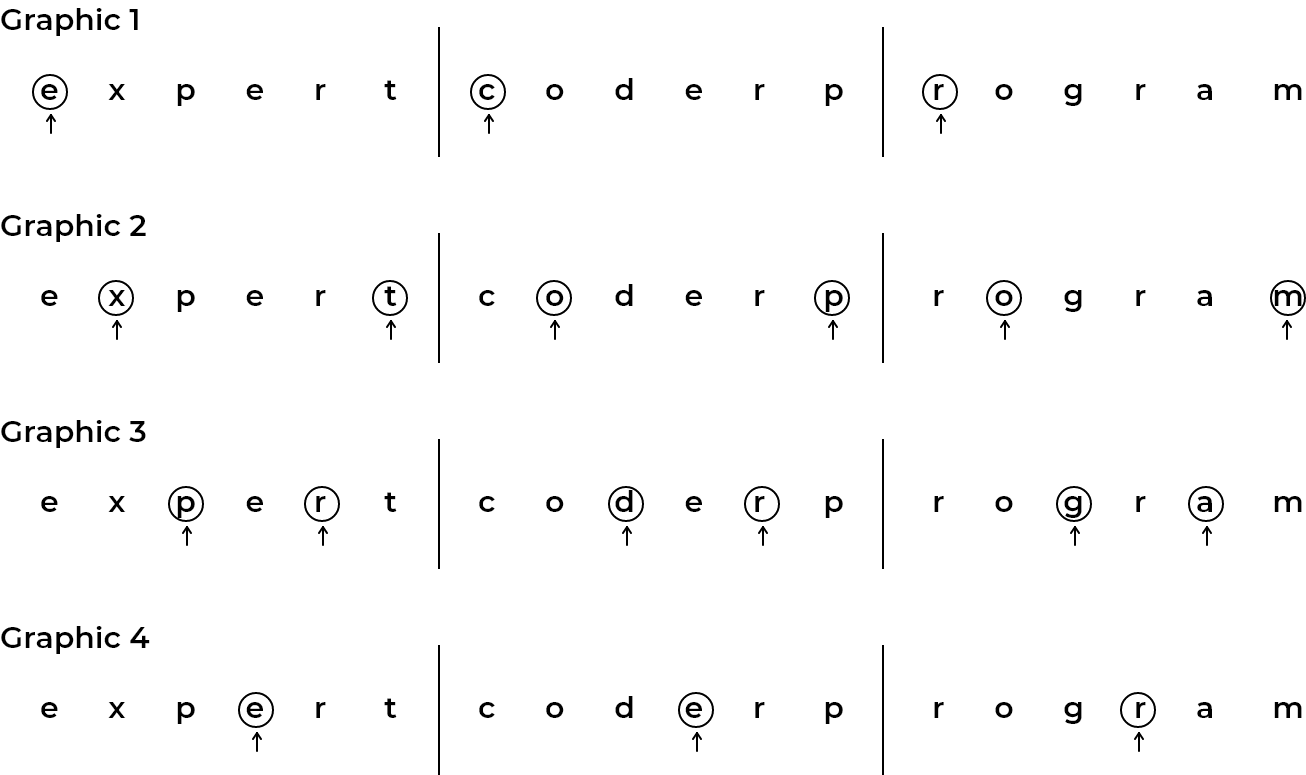Problem Statement (Simplified):
For a given string S and number of rows R, we have to arrange each character on rows in a vertical zigzag format, and then print values row-wise.
Can you guess the Time Complexity of this solution?
Test Case
Input:
1
9 3
prepbytes
Output:
pbsrpyeet
Example:
For string 'prepbytes' and '3' rows, we arrange it in the following pattern.
p.......b.......s
..r...p...y...e..
....e.......t....
Now we print this row-wise, so the answer will be 'pbsrpyeet'.Solving Approach :
1) To make a zigzag print, we print each character on the next row, and when row ends it goes back to 1st row. We repeat this pattern until the string ends.
2) As we can see pattern repeats once it reaches back to 1st row, So we divide the string into different parts and make a set of substrings for each repetition, each substring containing 2 x ( R - 1) characters. For the above example, the above string converts into 3 substrings that are prep, byte, and s.
3) Now we can see 1st row contains 1st element of each substring, and the last row contains a mid element of each substring.
4) For the rest of the elements, we notice every ith
row contains ith and ith element in serial pattern.
5) Now we know all the patterns, we print them in serial order from every substring keeping notice that the current element does not go beyond the size of the string.
Example
- Lets assume string
Sto be ‘expertcoderprogram‘ and number of rowsRbe4.- We can arrange this in this pattern :
e . . . . . . c . . . . . r . . . . .
. x . . . . t . o . . . p . o . . . m
. . p . . r . . . d . r . . . g . a .
. . . e . . . . . . e . . . . . r . .
- We can see in each repition pattern there are
i.e.
characters. Hence there are
6characters in each repetition pattern.- As length of string
Sis18, so there will be total3repetion patterns containing6elements each.- These repetions strings are ‘
expert‘, ‘coderp‘ and ‘rogram‘.- Let length of each repetition string be
N.- For every row we print:
For 1st row: We print 1st element of each repetition string.
See Graphic-1 Above
Hence we print
ecr.
For 2nd row: We print 2nd and (N-2+2)th` i.e. 3rd element of each repetition string.
See Graphic-2 Above
Hence we print
xtopom.
For 3rd row: We print 3rd and (N-3+2)th i.e. 5th element of each repetition string.
See Graphic-3 Above
Hence we print
prdrga.
For 4th row: We print 4th element of each repetition string.
See Graphic-4 Above
Hence we print
eer.
Solutions
#include <stdio.h>
int main()
{
int test;
scanf("%d", &test);
while(test--){
char a[1001], b[1001];
scanf("%s%s", a,b);
int found = 0;
if(strlen(a)>=strlen(b)){
for(int i=0; i<=strlen(a)-strlen(b) && !found; i++){
found = 1;
for(int j = 0; j<strlen(b); j++){
if( a[i+j] != b[j] ){
found = 0;
break;
}
}
}
}
if(found == 1)
printf("YES\n");
else
printf("NO\n");
}
return 0;
}
#include <bits/stdc++.h>
using namespace std;
int main()
{
int test;
cin>>test;
while(test--){
int N, R;
cin>>N>>R;
char a[N];
cin>>a;
int pairSize = 2*(R - 1);
if(pairSize == 0)
pairSize=1;
for(int i=0; i<=pairSize/2; i++){
for(int j=0; j<(N/pairSize)+1; j++){
int pos = i+(pairSize*j);
int revPos = (pairSize - i) + pairSize*j;
if( ((pos%pairSize)==0 || (pos+(pairSize/2))%pairSize == 0 ) && pos < N)
cout<<a[(i + pairSize*j)];
else{
if( pos < N )
cout<<a[pos];
if( revPos < N )
cout<<a[revPos];
}
}
}
cout<<endl;
}
return 0;
}
import java.util.*;
import java.io.*;
import java.lang.Math;
public class Main {
public static void main(String args[]) throws IOException {
Scanner sc= new Scanner(System.in);
int test = sc.nextInt();
while(test != 0){
int N = sc.nextInt();
int R = sc.nextInt();
String a = sc.next();
int pairSize = 2*(R - 1);
if(pairSize == 0)
pairSize=1;
for(int i=0; i<=pairSize/2; i++){
for(int j=0; j<(N/pairSize)+1; j++){
int pos = i+(pairSize*j);
int revPos = (pairSize - i) + pairSize*j;
if( ((pos%pairSize)==0 || (pos+(pairSize/2))%pairSize == 0 ) && pos < N)
System.out.print(a.charAt(i + pairSize*j));
else{
if( pos < N )
System.out.print(a.charAt(pos));
if( revPos < N )
System.out.print(a.charAt(revPos));
}
}
}
System.out.println();
test--;
}
}
}
for _ in range(int(input())): N, R = map(int,input().split()) a = list(input()) pairSize = 2*(R - 1) if(pairSize == 0): pairSize=1 for i in range(pairSize//2 + 1): for j in range((N//pairSize)+1): pos = i + (pairSize * j) revPos = (pairSize - i) + pairSize * j if( ((pos % pairSize) == 0 or (pos + (pairSize//2)) % pairSize == 0 ) and pos < N): print(a[(i + pairSize*j)], end = "") else: if( pos < N ): print(a[pos], end = "") if( revPos < N ): print(a[revPos], end = "") print()
Space Complexity
O(1)
[forminator_quiz id="1600"]
This article tried to discuss Backtracking. Hope this blog helps you understand and solve the problem. To practice more problems on backtracking you can check out .




